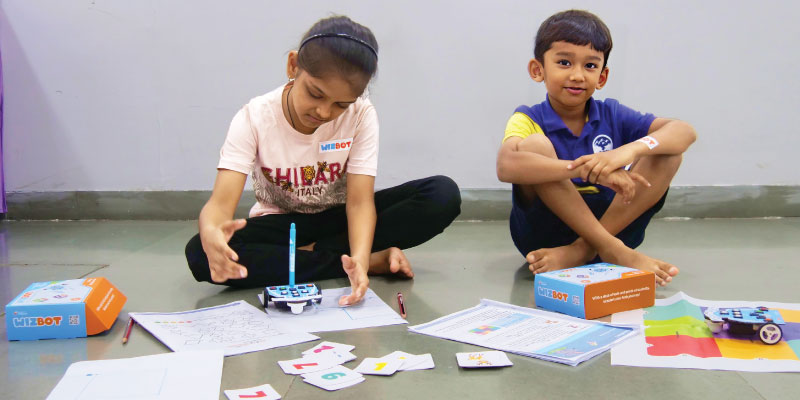Coined by the late Prime Minister Atal Bihari Vajpayee, 11th May is celebrated as National Technology day in India in the remembrance of the Pokhran Nuclear Tests of 1998. On this date every year, we take pride in the immense technological growth that India has made and the groundbreaking achievements of Indians in various fields of technology. Today, we take the opportunity to bring to the surface, the many ways in which technology has augmented the sphere of education in the country and continues to do so. The role of technology in education is huge as we all might be experiencing today with classes being conducted through video conferencing, imparting lessons through videos, usage of classroom applications, etc. Let’s have a deeper look at how the impact of technology on education has made the dispersal of knowledge better and simpler.
Also read: Technology and Education: Using Technology in the Classroom
Revolutionizing Learning: Use of Technology in Education

As today’s students are digital natives, making technology a part of their learning process is a great way to engage them and ensure full participation. The biggest advantages of technology in education are that it has interactivity as its best and leads to a better understanding of any subject than conventional teaching methods do. For Example, learning about electric conductors and insulators from textbooks will fail in comparison to learning the same creating an electric circuit and testing if it works with various substances; or learning mathematical calculations by playing simple games on an iPad; or learning about arts and culture by watching documentaries. Moreover, educational technology improves the retention of the knowledge gained, which is essential to learning. According to Shift e-Learning, digital learning increases learning retention rates by 82%.
The role of technology in education becomes more eminent as it facilitates learning according to the core requirements of the student. When learning through technology is personalized, the pace of introducing new information, the modality — visual, auditory, tactile, kinesthetic, and the number of repetitions; everything can all be adjusted accordingly. Such self-paced learning, or the overall impact of technology on education for that matter, brings us closer to an ideal education system.
There are multiple ways in which educational technology can enrich the learning experience. These include using videos as lessons, playing podcasts, using game-based learning platforms, online classes, online quizzes, and tests, etc. Bringing together many such links between education and technology and many more fun-learning activities, we have tried to create a one-stop learning platform for your kids at STEMpedia and expand the role of technology in education. Let us tell you how we’ve been able to do so.
National Technology Day, 2016: The Dawn of New Innovations
With an aim to bridge the technological gaps that we faced while working on projects during our college days, we created a Universal Testing Board and decided to take it forward as a start-up idea. However, we soon realized that we didn’t have a big enough market segment and went out for market research. We found out an answer, made several changes to the concept, and created evive – a device to solve all learning, project-making, and debugging needs, and launched it on Indiegogo in 2016, on National Technology Day itself.

With further research, we started exploring the younger market segment: pre-teens and teenage children who were at a very nascent stage of learning-by-doing or DIYing. Finding this segment appropriate and being aware of the advantages of technology in education, we started working on better hardware, easily usable kits, and quality learning content. Eventually, we came up with the evive Starter Kit, based on the previous-designed device, to simplify project-making. Along with that, we focused on making online courses with the help of which children could start from the very basics, a graphical programming interface for kid-friendly coding, a controller application, and a few more offerings.
As we realized the broader market’s need, we decided to create a one-stop STEM education solution that catered to every need with the aim of making quality education accessible to every student across the globe. This led to the birth of STEMpedia. Here, we better understood the role of technology in education.

Today, we have a range of tools and learning resources for learning-by-doing – from the state-of-the-art hands-on project-making kits, online courses, online tutorials, and projects to a kid-friendly programming interface, PictoBlox, and a powerful project-interaction mobile application called Dabble along with a newly launched course on coding called Introduction to Programming which is a perfect outset for anyone to learn to code and has got all that a beginner needs like interactive sessions, quizzes and assignment, fun challenges, and Scratch coding at the core. They all come together to help you learn while making complex modern projects with ease, thereby improving dexterity, algorithmic thinking, and problem-solving abilities of young minds; simultaneously signifying the impact of technology on education.
The Role of Technology in Education: A Bright Spot in the Lockdown

The impact of technology on education is such that today, students are easily able to continue with their academics even when the institutes are shut. In a way, technology is the only support on which schools and colleges are relying to keep up with learning. The role of technology in education doesn’t end here. Digital learning has made it easier for people to keep learning skills even during lockdown. Whether it is art, music, language, cooking, computers, exercise, or anything else that you want to form a grip on, with the internet, possibilities are limitless. One can pick anything they want to learn to do or build their knowledge on, and the internet will put on the platter numerous options to get through. Thus, it is only wise to use the many advantages of technology in education and learn new skills online, so that when everything goes back to normal, you can be ahead of your competition.
Future of Educational Technology

Studies reveal that 75% of educators believe that digital content will replace textbooks by the year 2026, and the advantages of technology in education will only multiply. Whether it is virtual reality, gamification, webinars, podcasts, or online classes, the stock of educational content and online learning resources is undoubtedly going to increase. The impact of technology on education is so huge that it is already transforming it, making it more efficient and exciting. The future of education, like many other areas of life, lies in the lap of technology.
Also read: Digital Learning: Why E-Learning Websites Are a Boon for Kids Today
In a Nutshell
We laid the foundations of STEMpedia on National Technology Day, exactly 4 years back and today, we are a part of a growing body of educational technology which is making STEM learning more accessible, more interactive, and more immersive than ever before. With the increasing use of technology in education and the growing insistence on digital learning, we are certain that students are only going to benefit from it. Besides, standing strong in the times of a global pandemic and carrying on with learning in every way possible, educational technology has a long way to go.








